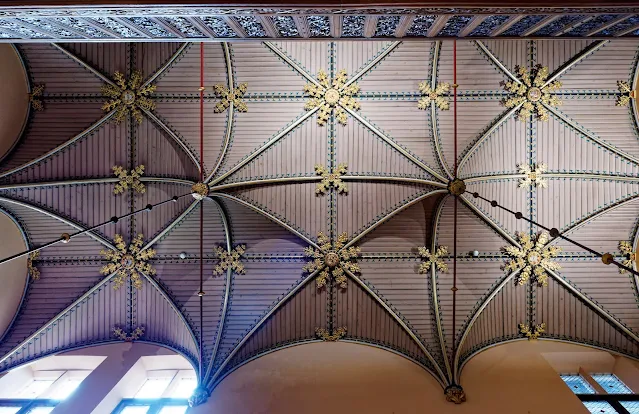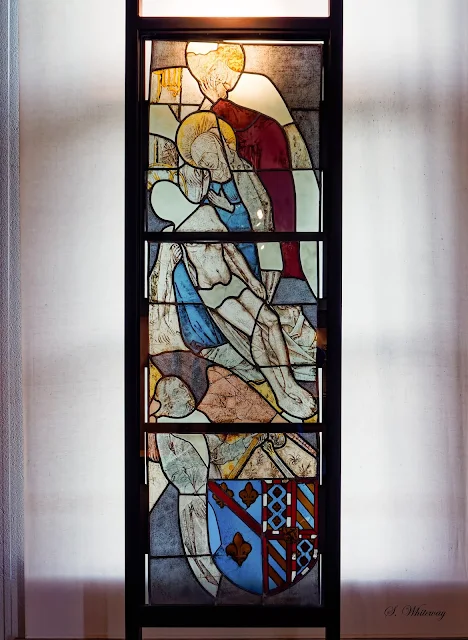 |
| Kasteel van Loopem |
 |
| Welcome to Castle Loppem! |
Stained Glass Windows
 |
| Small Family Chapel Stain Glass |
Staircases
 |
| Bannister Panels with Hunting Theme |
 |
| Bannister Panel |
 |
| Lion Newel Post Cap (Lions are part of the van Caloen Coat of Arms) |
Castle Interiors
 |
| Furniture by Pugin. Windows, chandeliers and fireplace by Bethune. Ca. 1860. |
 |
| Mural painting by Augustin Martin (1870) Captions by the Flemish poet Guido Gezelle |
 |
| Mural painting by Augustin Martin (1870) Captions by the Flemish poet Guido Gezelle |
 |
| Hooghuys and Sons Organ in Blue Room |
 |
| Ceilings |
 |
| Fireplace Mantle |
Works of Art
 |
| Pieta 1460 after Vrancke van der Stockt |
 |
| Madonna and Child Holland 15th-century |
 |
| Mary France or Maasland Netherlands 14th-century. |
 |
| Portuguese Ivory 17th-Century |
 |
| Male Saint France 13th-century |
 |
| Saint Sebastian Jan Borman Ca. 1520 |
 |
| Saint Margaret, crushing a devil or dragon under her feet France (14th century) sculpted in natural stone, polychromed |
The above figurine is based on a hagiography in the Legenda Aurea (compiled around the years 1259–1266) by Jacobus a Voragine; detailing the legend of Saint Margaret of Antioch (3rd century). She was a Christian martyr who resisted a devil and pressed him to the ground with her right foot.
 |
| Virgin Mary with a book, a devil under her feet, France (early 14th century) sculpted in natural stone, polychromed |
 |
| Devi (goddess represents the
universal Mother and the feminine element) sandstone from Chandella period 10th-11th century Madhya Pradesh, India, |
 |
| Swooning of Mary Antwerp Early 16th-century |
 |
| The Bruges Burg Square Anonymous, 17th century, oil on canvas |
 |
| Saint Jerome in the desert, After P.P. Rubens probably 17th century, oil on canvas |
The above painting is an old copy (smaller format) of the Saint Jerome of Peter Paul Rubens (ca. 1612-’15), kept in the Dresden Gemäldegalerie. Rubens portrayed the episode of Saint Jerome’s life as told in the epistle of Saint Eusebius and as popularised by the 13th century, Legenda Aurea. St. Jerome spent several years meditating in the Syrian desert. The traditional attributes of Jerome are portrayed; the skull symbolizing mortification, his books, and the lion whom he befriended by pulling a thorn from its paw.
The pose of the semi-naked, muscular male figure was inspired by a representation of St. Jerome by Titian, which Rubens had seen in Venice, and also by a statue known as the Dying Seneca (2nd century) in the Louvre, Paris.
Jean van Caloen, a grandson of Charles van Caloen, bought this well-crafted copy in 1913 from a Bruges antique dealer. Before that, the painting was in the possession of the family Depuydt in Poperinge.
 |
| Time for a Nap, 17th century, oil on canvas Gillis van Tilborgh (1625-1678), |
Gillis van Tilborgh (1625-1678), specialized in group portraits, paintings on the life of the lower class and elegant genre paintings. This painting has the monogram 'TB f(ecit)' which is how van Tilborgh signed his paintings. This painting is part of the van Ockerhout family legacy and was acquired as a result of the marriage of Albert van Caloen to Marie van Ockerhout.
 |
| Saint Jerome (ca 1550) copy of a painting by Joos van Cleve (ca 1485-1540) oil on canvas |
 |
| Catharina Peussin (Wife of Pieter Cassetta, alderman of the western district of the Franc of Bruges) 2nd quarter of the 17th century, oil on canvas |
 |
| Portrait of Charles van Caloen by Jean-Baptiste Anthony, autumn 1880, oil on panel |
 |
| Portrait of Joseph van Caloen by Flori Van Acker, 1922, oil on canvas |
Joseph van Caloen (1853-1932) was the oldest son of Charles van Caloen and Savina de Gourcy. In 1872 he entered the order of the Benedictines as 'dom Gérard'. He dedicated his life to missionary work. In 1893, the Pope charged him with the task of restoring the Benedictine order in Brazil. In 1906, he was appointed bishop in the mission area of the Rio Branco. In 1908 he became arch abbot of the Brazilian congregation. This portrait was painted by the well-known Bruges painter Florimond Van Acker (1858-1940), director of the Bruges art academy, a gifted painter of cityscapes, landscapes, genre scenes and portraits of notables and also an original designer of posters.
 |
| The Lamentation of Christ Antwerp Mannerism early 16th- century |
Antwerp Mannerism refers to an unidentified group of painters working primarily in Antwerp (but also in other Flemish cities) circa 1520 whose works bear certain characteristic features. Although attempts have been made to identify the individuals responsible for the several stylistic groups, most of the paintings remain attributed to anonymous masters. Characteristic of Antwerp Mannerism are works attributed to Jan de Beer, Jan van Dornicke, certain early paintings of Jan Gossart (1532) and Adriaen Ysenbrandt (1551). https://www.britannica.com/topic/Antwerp-Mannerists
 |
| A view of the castle grounds. For my fisher friends. |




